Boatspeed By Saskia Clark
Book Extract
BOAT SET-UP
Boat set-up is a huge topic and I’d recommend referring to Tuning to Win for more detail, but a few things to get you started:
- There will be loads of information on the internet about how to set up your boat, and most sailmakers will have a set-up guide for their brand which is the starting point. If you can’t find anything, ask the more experienced sailors in the fleet. It’s really important to get the basic onshore settings right and create a system so that you can change between them whilst you are on the water.
- With a permanent marker, mark where you are pulling the jib halyard to, record what shroud pin number you are on, make a calibration system for your jibsheet – this is the only way to create a repeatable tuning guide.
- Measure things before you sail and when you come in and keep a record of the conditions and how you were going, building up your own tuning guide.
UPWIND SPEED
Jib Set-Up
Even though the jib is the small relation to the mainsail, it makes large contribution to your performance upwind and, as the crew, it is your domain. The jib’s main job is to accelerate wind on to the leeward side of your mainsail and you need to set the jib slot to get the optimum power from the wind.
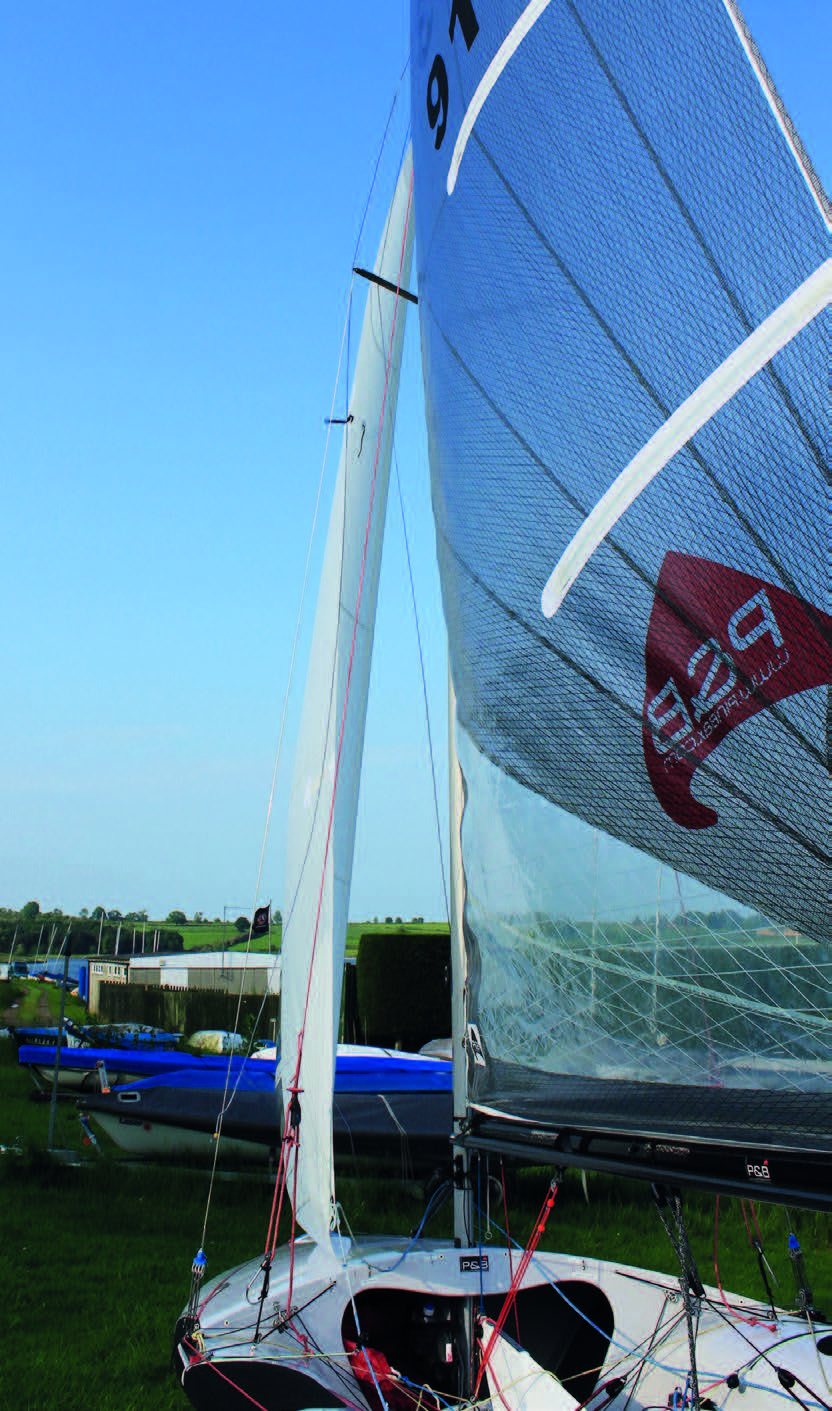
The jib slot between the jib and mainsail
In under-powered conditions you are trying to squeeze as much energy from the wind without making the gap so hard to get through that the wind just doesn’t bother. When you are overpowered, you are trying to lose and spill wind from the leech of the jib because the wind strength is too much for the boat to cope with. And in between those two states is ‘max power’ when your jib leech is set at its tightest.
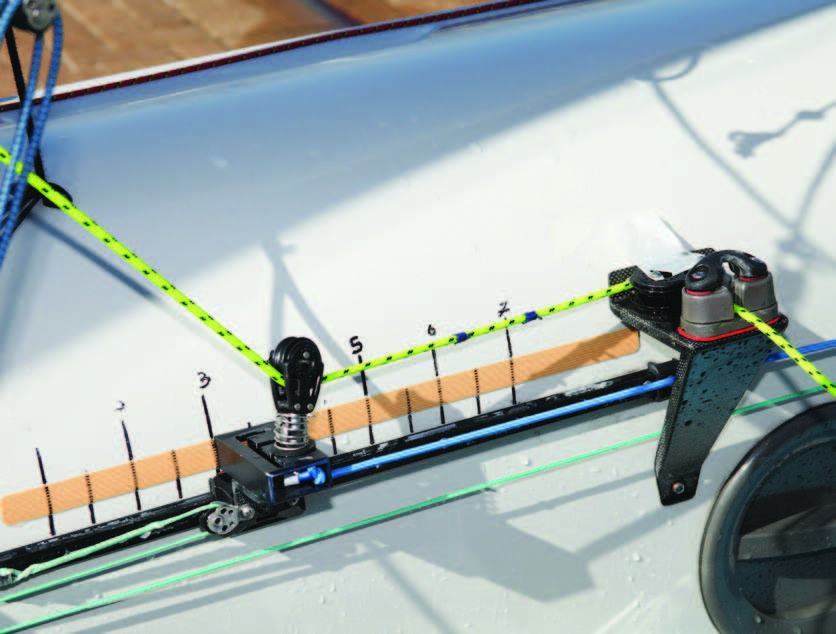
Jib control system in the 470 with a jib car (fore & aft)
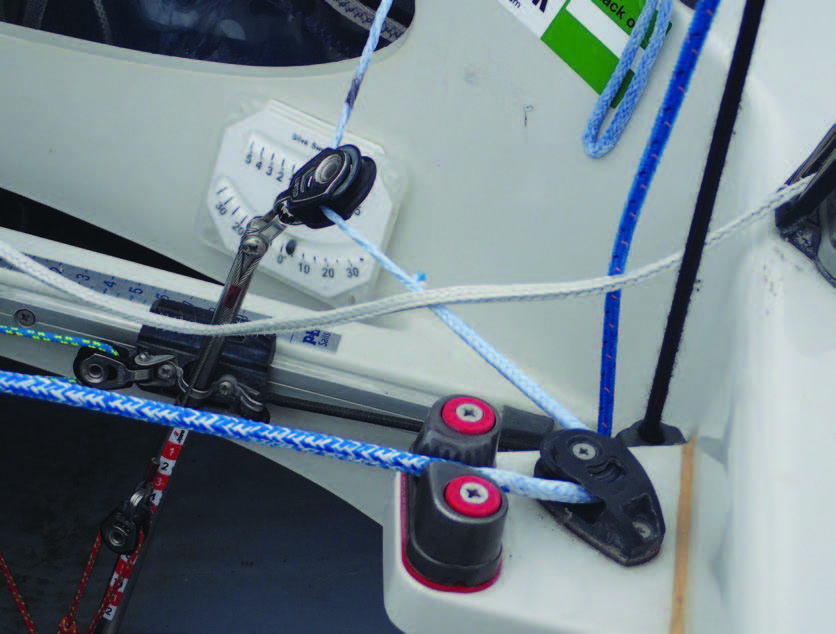
Jib control system in a Fireball with a jib car (sideways) and piston (equivalent of a fore & aft jib car)
Control of the jib leech is a combination of two main elements: the jibsheet and jib car position. You might not have an adjustable jib car in your boat, if so, you would use the windward / lazy jibsheet instead. To understand the effect of the sheet and car, rig up the jib in 6-7 knots of wind and look how the two elements affect the sail. If you pull only jibsheet the leech will be straight, using jib car (or the windward jibsheet) puts a curve in the jib leech. Look at the shape the foot of the jib is making on the foredeck, using jibsheet makes a straight line (a flat jib) and jib car makes a semicircle (a deep jib). Look how much movement of jibsheet or jib car it takes to change the shape. The object is to mirror the shape of the mainsail as you look at the boat from behind, but as a crew you don’t have that viewing perspective when racing.
Three visual tools to get you in the ballpark of correct jib set up are:
1. Make a small mark half way down the luff of your jib (either measure it or fold it in half). Draw an imaginary line from that point to the clew of your jib and with a permanent pen mark the final 10cm (4in) by the clew. The starting point for a powerful sheeting angle is when the jibsheet is a continuation of that pen line. If you are trying to encourage flow over the sail because it’s light or get rid of flow because it’s windy, then move the car back from that angle (to open your jib leech); if you are looking for more power, go forward of that mark (to close or tighten the jib leech).
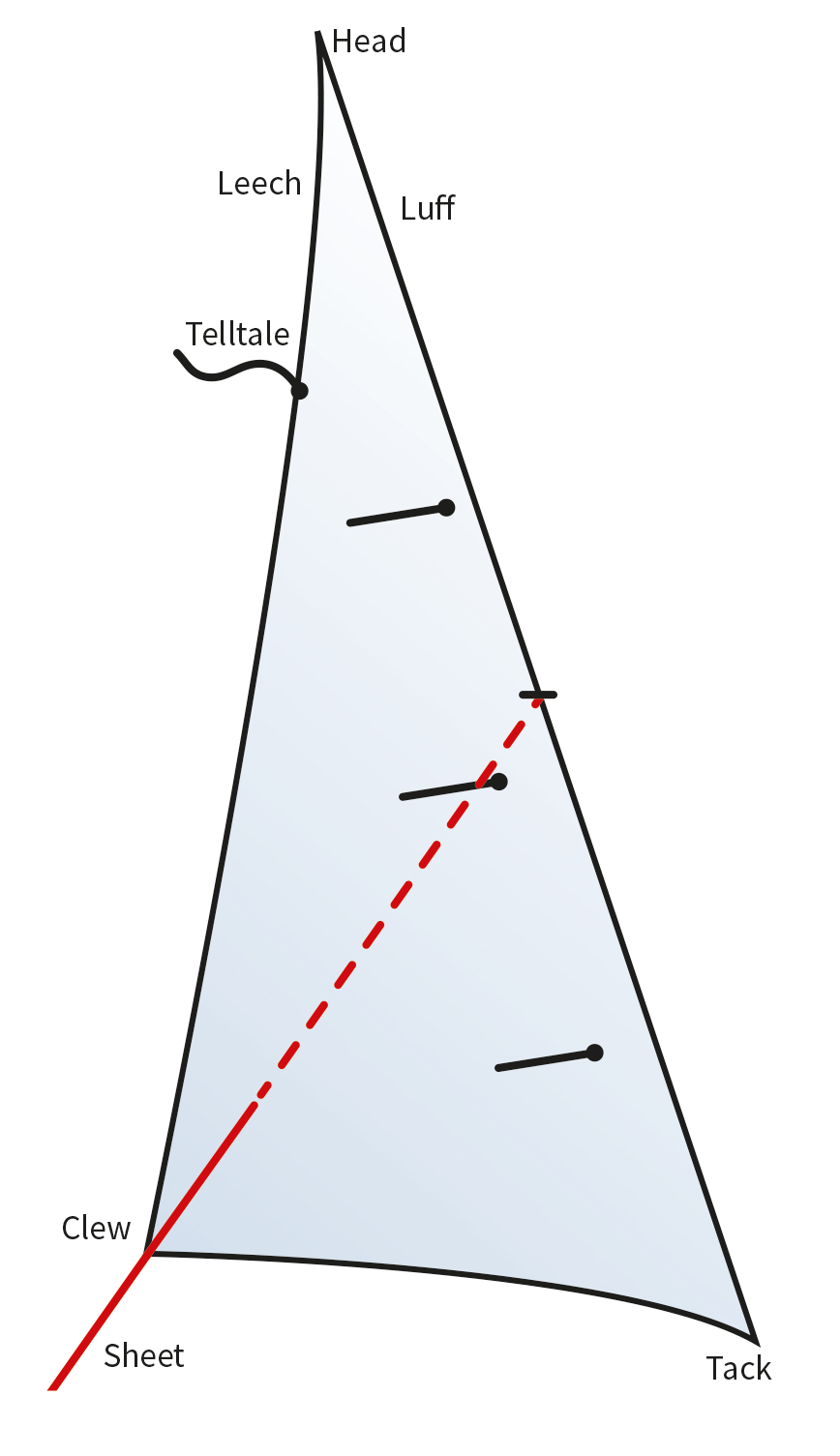
2. A telltale on the jib leech, a hand width underneath the top batten, or if you have no batten, about a quarter of the way down the leech is a sail-tuning must. This telltale shows the flow of air on the exit of your sail. If it is flying horizontally you have flow, if it is curling behind the jib the wind is stalling.
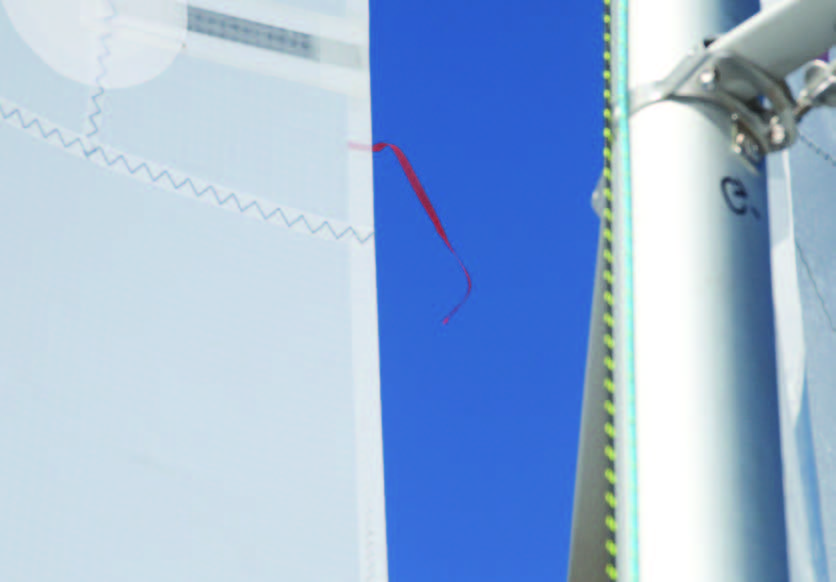
A telltale on the jib leech is a sail-tuning must
3. Foredeck marks give you a visual aid as to the depth of your jib. If you are new to the boat, figuring out the right place for this can be hard. My best advice is go and have a look at someone who is fast and copy what they have! If that isn’t an option, thread some twine through the bottom forestay fixing point to the shroud and mark a 10cm line where the middle of the jib foot would sit. In the 470 you would make 2 further parallel lines at 5cm intervals towards the gunwale, but the exact measurements may differ for other classes – ask your sailmaker.
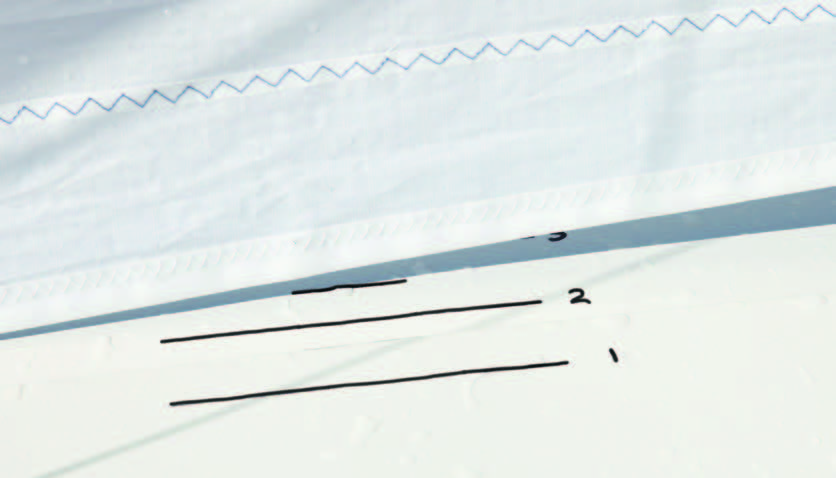
Lines on the foredeck to give a visual aid to the depth of the jib
4. Put a mark on the jibsheet and some calibration marks on the deck that the jibsheet runs past. This is just for a quick visual reference, out of manoeuvres, that you are near the right place.
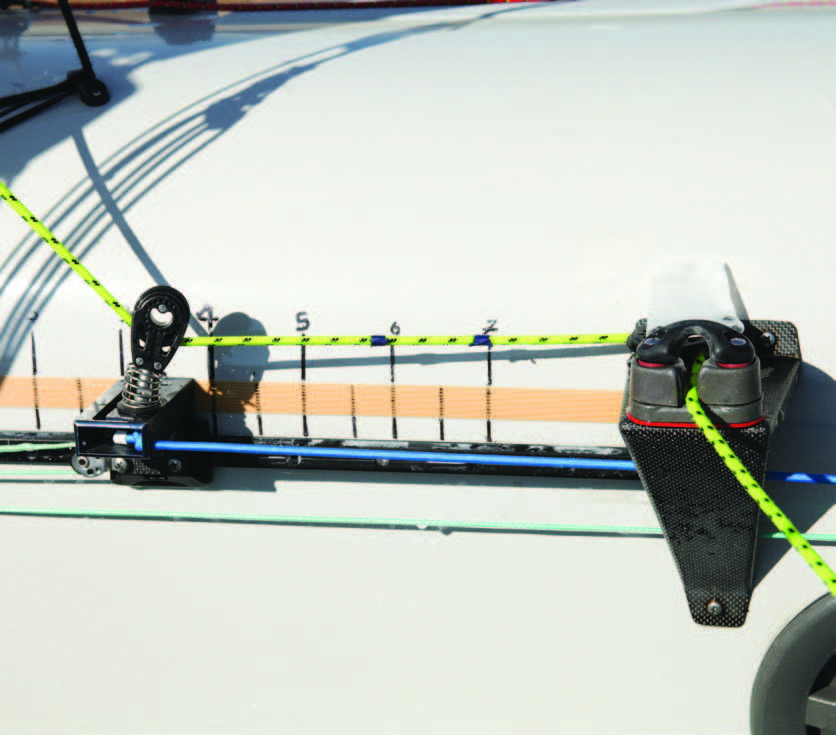
Mark your jibsheet and put calibration marks on the deck
In simplistic terms:
- A deep jib with a tight leech adds power, until you go too far.
- A flat jib is less powerful but creates an easy shape for light wind to travel across, again until you go too far.
- An open leech gets rid of power.
These visual aids will show you what you need to do with the jib, but you need to decide how to achieve it: with jibsheet or jib car? For example, if the leech telltale is wrapped around the back of the sail, you need to open the jib:
- You need to ease more jibsheet out to get the telltale flying more but, as you do that, you are losing drive from your jib (the front starts caving slightly), as it is just too far out on the sheet.
- So, go forward on your car setting, which makes your leech tighter, but ease the jibsheet to get the telltale flying.
- So, the base of your jib is still pulling, but you have opened up the top.
When you are on the water consider the wind strength, sea state and the feeling in the boat when sailing in a straight line and discuss what you need from your jib:
- Is it light, sitting-in-the-boat conditions? If so, you need to encourage flow over your jib and onto your mainsail = LOOKING FOR POWER
- Is it hiking / trapezing conditions and there is room for the boat to take more wind before you would be over powered? If so, you are looking to squeeze as much wind as possible onto the mainsail = LOOKING FOR POWER
- Are you already completely overpowered? If so, you need to lose wind from the mainsail = LOOKING TO LOSE POWER
- Is there a chop / wave that you are smashing into? If so, you need a forgiving jib set-up that will cover a few bases: sometimes you need power, other times you need to get rid of it = BIT OF EVERYTHING.
Light Wind
In the lighter wind you need to have a more ‘open’ jib leech to encourage the weak, less powerful air across your jib, through the slot. Have the leech telltale flying 80% of the time, stalling 20%. As the wind builds you can increase the amount of time it is stalling.
Building To Max Power
As the wind builds, it has more energy and can push through that gap more easily, so you need to tighten your jib leech, maximising the power you can take out of the wind. As you hit the toestraps or the trapeze wire the jib can take a significant pull in. Have the leech telltale stalling 80% of the time and flowing 20%. This will be a gradual tightening all the way up to max power, when your jib leech will be at its tightest. If your jib leech telltale is constantly flying, your jib leech is too open; if it is constantly wrapped around the leech of the sail, your jib is too tight.
Beyond Max Power
When you get beyond max power, you now need to start losing (spilling) wind from your sail, because your body weight can no longer balance it out, so you start opening the leech again. The leech telltale becomes less useful in these conditions as it will permanently fly, unless you are over tight. Instead look at the luff of the mainsail. If you are sailing upwind in a straight line and the mainsail luff is constantly back-winding, it is being caused by wind firing off the back of jib into the luff of the mainsail and it’s not fast. You want both sails to be pulling together, not one disrupting the airflow over the other. So, ease the sheet until you are back-winding 20% of the time.
Chop
I think choppy conditions are the hardest to set up for: what you need from your jib is constantly changing, you need power to punch through the difficult water and, if you hit a bad wave and the boat starts loading up, you need to quickly get rid of that power and encourage flow so you can accelerate. In these conditions you would set your jib up at it’s most ‘twisted’: with a deep base that gives you the power, but an open top leech to give you the forgiveness so, if you keep hitting waves, you can re-accelerate. So, it would be jib car forward, jibsheet eased.
Essentially the correct jib set-up is a blend of both jib car and sheeting position. It’s not an exact science and has a large element of personal preference and feel to it. Also, the boat is always in transition from one state to another, so you have to be fully on top of what is coming on to your boat and sails next and what you need to change the set up to. I’ve vastly over simplified it here, so would encourage you to understand it deeper by reading the Tuning to Winbook in the Sail to Win series.
Technique Practice
The next element of speed is your technique both individually and how you work together. It’s hugely boat, wind speed and wave state specific. The two main elements are boat heel (side-to-side) and boat trim (front-to-back).
Sailing in a straight line you need to be looking at the wind that will be hitting your boat in the next 20 seconds and anticipating what you need to do with your body position and jibsheet position to maintain maximum speed.
Boat Heel
As a general rule across boats, when it’s light wind you want leeward heel: this helps the helmsperson steer as it gives them weight through the tiller. As soon as the wind builds, and you get some boatspeed on, you feel like you can squeeze some power on and the boat needs to be flat. From this wind speed through to max power and up the wind range most boats will want to be flat. If you are in a planing boat, they like to sit on their planing surface upwind, which could well be flat but, depending on design, it might be with a few degrees of leeward heel.
Most of the boat heel work is the crew’s job, but there might be a few conditions where, as a team, you feel it is more accurate and less disruptive to the boat and sails if the helm takes charge of it. For my team this was ‘crew in the boat conditions’ when I was wedged down in a tight ball between the gunwale and side deck. The helm could control flattening the boat in the early stages of the building wind.
In the condition where you are just thinking to commit to the trapeze or the toestraps, it can be worth both helm and crew gently hiking until the wind is solidly established. That stops any disruption to the mast as you hook on and off if the windspeed fluctuates and sometimes drops down.
At max power, as a team, you are desperate to not be the first boat in the race to start giving away power, either by having to dump some mainsheet or depower the sail by pulling on kicker, so you need to do everything you can to increase your leverage. Trapezing or hiking off your tiptoes, your front arm over the head, getting your clothing wet so you weigh a bit more, anything so you can keep holding the power.
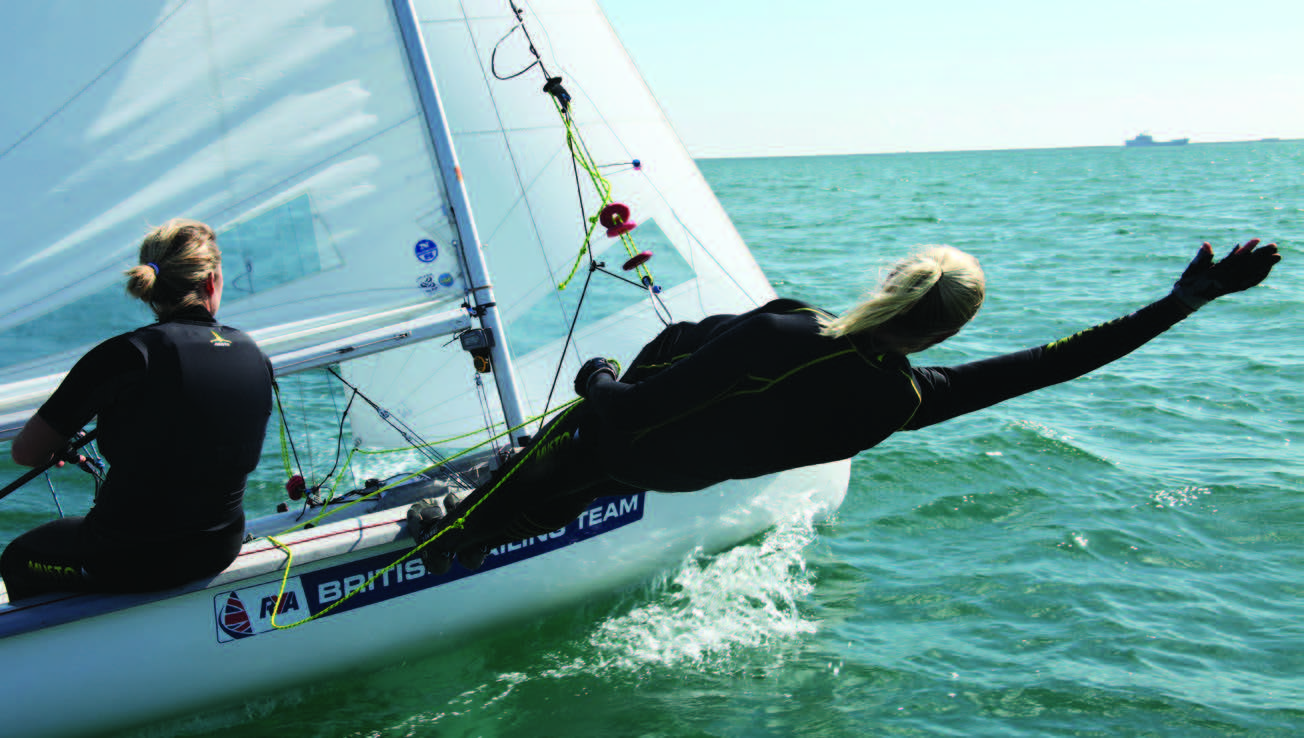
As you move to max power, do everything you can to increase leverage
Whatever the situation requires heel wise, you want don’t to be yo-yoing around between flat and heeled. As you can imagine, that disturbs the wind and water flow around your boat and isn’t fast. If you are struggling to keep it dead flat, have a bit of heel on and aim to keep that consistent.
Boat Trim
Boat trim wise, if it’s light winds, move your body weight as a team as far forward as possible to get the wide transom of your boat, which you are dragging around, out of the water. But you can go too far forward so, if it sounds and feels like you are ploughing through the ocean, then that’s too far!
As the wind builds you want the maximum waterline length from your boat as that will get it up to maximum speed. So, as a team, spread out a bit, your crewing position will start off near the shrouds and, as the wind builds more, move further back to the widest part of the boat, where you have maximum leverage. There will be little bits of chop or wave to move forwards or backwards on, whichever feels the right thing: this will help the boat keep smooth and not bounce around.
As you move into planing mode you need to move back to ‘pop’ or free the bow out of the water so you don’t plough into the waves. It also puts the boat onto its planing surface, which is the most efficient for speed.
A huge element of performance is how you transition through these modes as the wind builds or drops. If you are planing in a gust with weight back but about to enter a lighter patch, it is hugely important not to waste any time in moving forward and sheeting your jib harder so the helm can instantly head up, transitioning to displacement sailing and vice versa if you are trying to plane.
In a fast asymmetric trapeze dinghy, the trapezing position moves aft once it is windy enough to plane upwind: by about 70cm in an RS800 for example. You should see the knuckle of the bow lift out the water when the sea is flat. The decision on when to trim back should be made by the person who is sheeting the main because they can feel when the boat is ready to plane.
Up & downwind (but particularly upwind): If trapezing in a double trapeze boat, keeping both helm and crew bodies at same height and close together reduces windage which is important for speed in windy conditions for a boat driven by apparent wind.
Communicate with the helm to agree your trapezing height and fore & aft trim.
Body Weight
The final upwind technique element is how you can use your body weight to flick the leech (back part) of the mainsail, called bouncing or pumping, which accelerates wind off the back of the sail. This is controlled by Rule 42 so is prohibited upwind unless your class rules create an exception, which increasingly classes are doing at a certain wind strength.
The outcome you are trying to achieve is movement in the mast, which then affects the sail. It is easy to feel a jolt through the boat that doesn’t translate to any effect on the sail. If you are trapezing this will be a fast jolt downwards with the hips, so the energy goes straight up the wire. It is not a flick through the feet or ankles. Use this technique when you are over powered and need to exhaust some wind out of the sail, so at the top of a wave or as a gust hits to get you back to upright.
This unprohibited pumping is also being increasingly used in under max power conditions: the flag to allow it has to be hoisted (Flag O). In this situation it is not being used to exhaust wind out of the sail but to increase the power and go faster. You are trying to repeatedly replicate the pull down out of a roll tack and essentially row yourself faster through the wind.
Give the boat a little leeward heel and then pull down through the trapeze wire to vertical: rhythmically repeat this process and you will feel that, as the boat gains speed, you will be able to build the force and speed that you can pull through the wire. The technique and application of this style of pumping are constantly evolving so if it’s happening in your class, watch and speak to the experts to understand how and when to use it.
© Not to be reproduced without written permission from Fernhurst Books Limited.
Crewing to Win is written gold and silver medallist Saskia Clark. It contains invaluable advice for anyone who sails a two-person boat, not just crews!